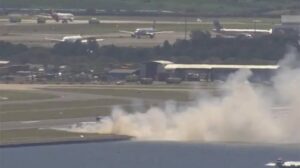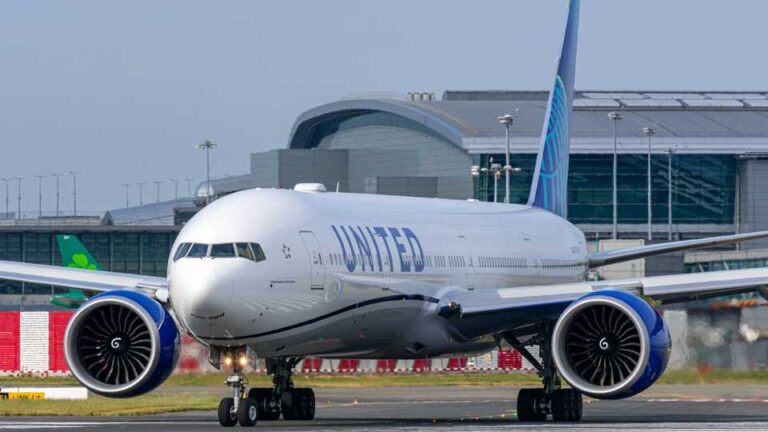Qantas Flight Escapes Disaster After Engine Failure During Takeoff
Qantas Flight Escapes Disaster After Engine Failure During Takeoff
A potential disaster was narrowly avoided in one of the most harrowing incidents in Qantas Airways’ history. A Qantas flight, operating a regular domestic route, experienced a catastrophic engine failure during takeoff, leading to a tense situation for both the passengers and crew on board. Fortunately, quick thinking, exceptional training, and the airline’s safety protocols ensured that the flight escaped what could have been a devastating crash.
The Incident Unfolds
The incident occurred on a routine flight departing from Sydney International Airport, bound for Melbourne. The aircraft involved was a Boeing 737-800, one of the most commonly used aircraft in Qantas’ fleet for domestic and regional flights. The weather on the day was clear, with no indications of adverse conditions that might have affected the flight. The flight crew had completed all pre-flight checks, and the aircraft was deemed to be in normal operating condition.
However, just moments after takeoff, as the plane climbed into the air, one of the aircraft’s engines failed unexpectedly. The failure occurred during the critical phase of flight, shortly after the aircraft had lifted off the ground. A sudden and unexpected loss of power in one of the engines during takeoff is a rare and alarming event, as this stage of flight demands maximum engine performance to ensure a safe ascent.

The engine failure led to a massive power loss, resulting in a sharp drop in altitude and causing the aircraft to tilt sideways. Passengers aboard the plane reported a sudden jolt, followed by a loud bang and a visible decrease in speed. Despite the terrifying noise and the turbulence that followed, the flight crew remained calm and immediately began executing emergency procedures designed to handle an engine failure.
Immediate Response from the Crew
The flight crew, led by the captain, who had years of experience and a history of handling emergency situations, swiftly initiated a series of emergency protocols. The crew followed standard operating procedures for an engine-out situation, which included maintaining the aircraft’s speed, adjusting its altitude, and communicating with air traffic control to declare an emergency.
The captain, with the assistance of the first officer and the flight attendants, ensured that all passengers remained calm and prepared for a potential emergency landing. The passengers were instructed to fasten their seatbelts, brace for impact, and assume crash positions as the crew prepared for the worst-case scenario. Meanwhile, air traffic control immediately cleared the airspace to provide the aircraft with the necessary space to maneuver and make a return to Sydney.
The crew’s calmness under pressure was a testament to their rigorous training and the airline’s commitment to safety. They successfully managed to maintain control of the aircraft despite the loss of engine power, preventing what could have been a disastrous outcome.
The Emergency Landing
After managing the initial shock of the engine failure, the crew began preparing for an emergency landing back at Sydney International Airport. The aircraft, now operating with just one engine, was forced to make a difficult and challenging landing. With a significantly reduced speed and altitude, the crew needed to navigate the plane back toward the runway with precision, ensuring that the remaining engine did not overstrain and cause additional mechanical problems.
Air traffic control immediately cleared the runway, and emergency response teams were placed on standby, prepared to respond quickly in case the landing was unsuccessful. The aircraft made a controlled approach to the runway, and the pilot successfully executed a flawless landing despite the compromised engine power. The landing was smooth, and the aircraft came to a complete stop without incident.
Upon landing, the passengers were quickly evacuated by the cabin crew, and emergency services were on-site to ensure that there was no fire or further danger. Thankfully, no one was injured during the incident, and all 150 passengers and crew members were safely evacuated. The response from both the crew and emergency teams ensured that the situation remained under control from the moment of the engine failure to the safe conclusion of the emergency landing.
Investigation and Findings
Following the incident, Qantas launched a thorough investigation into the cause of the engine failure. The airline’s engineers and safety experts worked alongside the aircraft manufacturer and relevant aviation authorities to determine the root cause of the failure. Preliminary findings indicated that the engine failure was the result of a mechanical malfunction, likely involving a critical component within the engine. This component had failed unexpectedly, leading to the power loss during takeoff.
It was noted that this kind of engine failure is extremely rare, and the aircraft involved had undergone regular maintenance checks prior to the flight. The investigation confirmed that the flight crew had followed all safety procedures to the letter, and no human error was involved in the incident. Furthermore, the findings emphasized the critical role that the aircraft’s design and safety systems, such as the auto-throttle and emergency protocols, played in allowing the crew to maintain control of the situation.
Qantas also used the incident as an opportunity to review its emergency training procedures and ensure that all pilots, crew members, and ground staff were up to date on the latest safety protocols and equipment. The airline, known for its stringent safety standards, reiterated its commitment to passenger safety and vowed to continue investing in the latest technology and training to ensure that such incidents are minimized in the future.
The Aftermath and Safety Improvements
In the aftermath of the engine failure, Qantas faced scrutiny from the media and the public, but the airline’s transparency and quick response helped to reassure the public of its commitment to safety. Qantas released a statement acknowledging the seriousness of the situation and assuring passengers that all necessary measures were being taken to investigate the cause of the engine failure.
The airline also emphasized that incidents of this nature are exceedingly rare, thanks to the rigorous maintenance procedures and high safety standards in place across its fleet. Qantas reassured passengers that the incident was an isolated event and that the company was doing everything possible to ensure that such a situation would never occur again.
In the broader context, the incident prompted renewed discussions within the aviation industry about the importance of continuous safety improvements, particularly regarding the maintenance and operation of aircraft engines. Several other airlines began reviewing their own safety procedures and protocols in light of the close call, leading to a series of improvements across the global aviation industry.
Conclusion
The Qantas flight that experienced a near-disastrous engine failure during takeoff serves as a powerful reminder of the risks involved in aviation and the importance of preparedness. The skill and professionalism of the flight crew, combined with the effectiveness of Qantas’ safety measures, ultimately ensured that a potential tragedy was avoided.
Though the incident was a close call, it also highlighted the exceptional training that airline crews undergo to handle such extreme situations. Thanks to the quick thinking and calm demeanor of the crew, the passengers were able to walk away from what could have been a deadly disaster.
In the wake of the event, Qantas reaffirmed its reputation for safety, emphasizing that every effort would be made to learn from the incident and to continue improving its systems to ensure the safety of all passengers in the future. While the engine failure was a frightening event, it served as a testament to the resilience and expertise of the airline and its crew.






